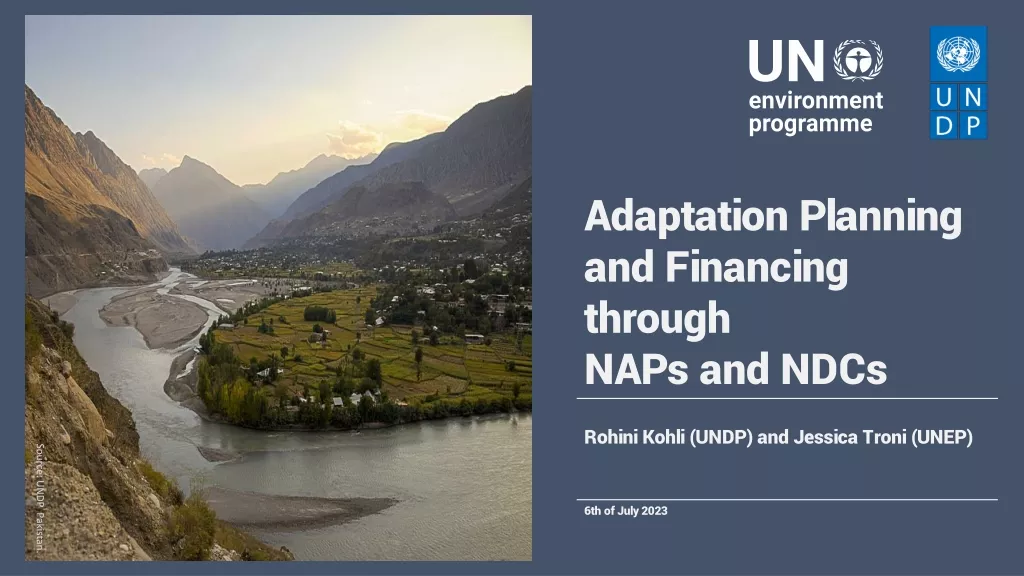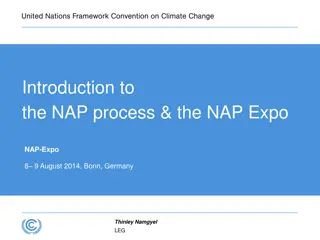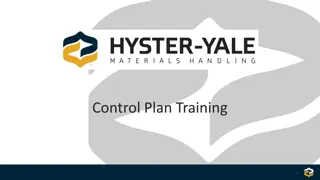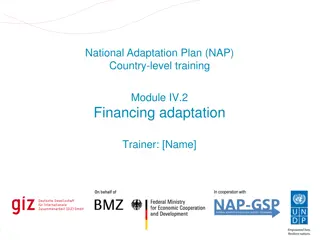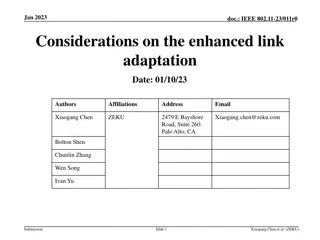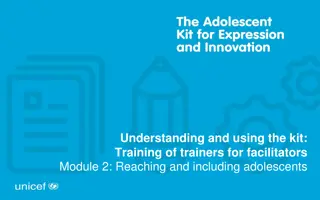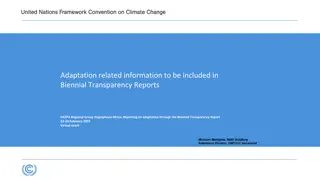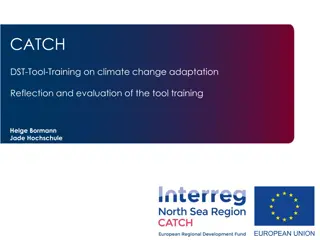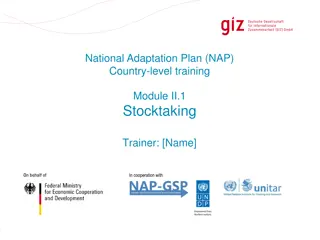Developing and Selecting Adaptation Options in National Adaptation Plans: A Training Module
This training module focuses on the importance of selecting and prioritizing adaptation options in the National Adaptation Plan (NAP). It covers different assessment approaches, criteria for selecting options, decision support tools like Cost-benefit Analysis (CBA), and the necessity of prioritizing due to limited resources. Participants will learn methods to support decision-making and apply criteria for prioritization.
Download Presentation

Please find below an Image/Link to download the presentation.
The content on the website is provided AS IS for your information and personal use only. It may not be sold, licensed, or shared on other websites without obtaining consent from the author.If you encounter any issues during the download, it is possible that the publisher has removed the file from their server.
You are allowed to download the files provided on this website for personal or commercial use, subject to the condition that they are used lawfully. All files are the property of their respective owners.
The content on the website is provided AS IS for your information and personal use only. It may not be sold, licensed, or shared on other websites without obtaining consent from the author.
E N D
Presentation Transcript
National Adaptation Plan (NAP) Country-level training Module III.2 Develop and select adaptation options Trainer: [Name] In cooperation with Slide 1
Overview of this module Why do we select between different options and why it is necessary to quantify the costs of adaptation options Different assessment approaches: Cost-benefit analysis Cost-efficiency analysis Multi-criteria analysis Take-away messages Slide 2
What can you expect to learn from this session? Understand the necessity of prioritising adaptation options Get introduced to different methods that support decision-making Apply criteria for prioritization Slide 3
What are adaptation options? Improved resource use Threat management Impact prevention Migration Capacity development Slide 4
Why is it necessary to select/prioritize among adaptation options? Limited resources for implementation Financial means, time, institutional capacities, people, etc. Lack of knowledge on scope of investment To know, how much has to be invested, when it should be invested and whether options are economically viable Selection or prioritization needs dialogue for everybody to accept the results. Agreed criteria assist the process. Slide 5
Possible criteria for selecting and prioritizing adaptation options Effectiveness Costs Feasibility Urgency of taking action No regrets measures Political and social acceptance Alignment with funding requirements Biodiversity friendliness What would be important to you? Slide 6
Decision support tools Cost-benefit Analysis (CBA) Cost-efficiency Analysis (CEA) Multi-criteria Analysis (MCA) Slide 7
Cost-benefit Analysis (CBA) Overview = Basically the comparison of the costs and benefits of a project Advantages Informs on economic viability of an adaptation option Allows for prioritisation between alternative adaptation options in monetary terms Limitations Costs and benefits must be measureable in monetary terms Slide 8
Cost-efficiency Analysis (CEA) Overview = Cost analysis of alternative adaptation options Compared with CBA, only suitable where benefits cannot be defined in monetary terms Advantages Give information on how an objective can be achieved in the most efficient way Limitations Measurable objective required Costs need to be defined in monetary terms Slide 9
Multi-criteria Analysis (MCA) - Overview = Tool that is able to rank and prioritize multiple adaptation options. Ranks resulting from an MCA are not based purely on economic calculations but on a qualitative assessment of criteria. Advantages MCA allows for prioritization and helps identify trade-offs and win-win situations! Need to find a common indicator (e.g. scores) scores can be calculated (if quantitative judgment is available) or be obtained via expert consultation Limitations MCA is more subjective than other methods MCA tells nothing about economic efficiency Slide 10
Selecting a method for assessing adaptation options Is it possible to measure costs in monetary terms and quantify benefits at all? CBA = Cost-benefit Analysis CEA = Cost effectiveness Analysis MCA = Multi-criteria Analysis Slide 11
Multi-criteria analysis: an example from Mexico The Special Programme on Climate Change establishes specific adaptation goals for sectorial ministries. Due to a lack of resources, projects need to be prioritised. MCA ensures that important criteria are met. It is used by four government bodies. Establish the context Identify measures Select criteria and indicators Validate criteria and indicators Assign a weight to each criterion Score measures Calculate overall values Examine and test results 1 2 3 4 5 6 7 8 Slide 12
Take home messages Adaptation options range from less to more costly! Ensure transparency and validate results Benefit from existing data and knowledge Do not use too sophisticated tools if data is the problem Make use of a proper mix of assessment tools, i.e. combine CBA and MCA Tools are not an end in itself but means to achieve an objective Slide 13
Exercise: short version of a multi-criteria-analysis You are invited to evaluate the feasibility of each action in matrix III.2.1 In this exercise, you will apply only the given criteria: technology available cost intensity; and political and social acceptance Working in sub-groups Slide 14
Imprint Published by Deutsche Gesellschaft f r Internationale Zusammenarbeit (GIZ) GmbH This presentation is part of a NAP country-level training that has been developed by GIZ on behalf of BMZ and in cooperation with the NAP Global Support Programme (NAP-GSP), in particular UNDP and UNITAR. Climate Policy Support Project Dag-Hammarskj ld-Weg 1-5 65760 Eschborn, Germany T +49 61 96 79-0 F +49 61 96 79-1115 The training is designed to support countries in setting up a National Adaptation Plan (NAP) process. It builds on the NAP Technical Guidelines developed by the Least- Developed Countries Expert Group (LEG). Contact E climate@giz.de I www.giz.de/climate You are welcome to use the slides, as long as you do not alter its content or design (including the logos), nor this imprint. If you have any questions regarding the training, please contact Till Below or Nele B nner at GIZ. For questions related to the Technical Guidelines, please refer to the UNFCCC s NAP Support Portal. Responsible Nele B nner, GIZ Authors Nele B nner, Annette Lutz As a federally owned enterprise, the Deutsche Gesellschaft f r Internationale Zusammenarbeit (GIZ) GmbH supports the German Government in achieving its objectives in the field of international cooperation for sustainable development. GIZ also engages in human resource development, advanced training and dialogue. Slide 15


